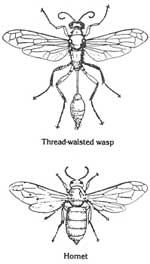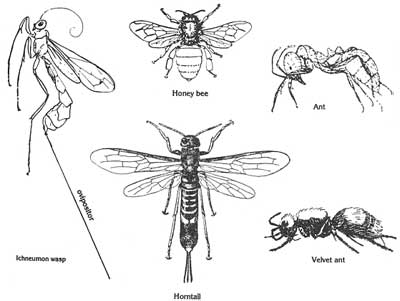Hymenoptera: Wasps, Bees, Ants, Sawflies, Horntails
(from the Greek: hymen = membrane + ptera = wings)
Hymenoptera have chewing mouthparts and either two pairs of membranous wings or no wings. When winged, the front pair is longer than the hind pair. The antennae are well developed and often are quite long. In bees, wasps and ants, the body is constricted between the thorax and abdomen, but in sawflies and horntails the abdomen and thorax are broadly joined. All Hymenoptera develop have complete metamorphosis.
Some Hymenoptera are solitary, others are organized into highly socialized colonies. The greatest degree of social organization occurs among the honey bees, but ants are also highly socialized. The social organization of wasps is not as complex. None of the sawflies or horntails live in colonies.
Many of the Hymenoptera, in the process of feeding on pollen, also pollinate flowers and are useful insects for this reason. Honey bees also produce honey, wax, and propolis. Other Hymenoptera are beneficial predators or parasites of pest insects. Many species of sawflies and horntails are pests which feed on leaves or bore in wood. Some bees, wasps and ants are pests. Those that can sting cause the most concern. Some people are highly allergic to such stings and may die as a result of stings.


